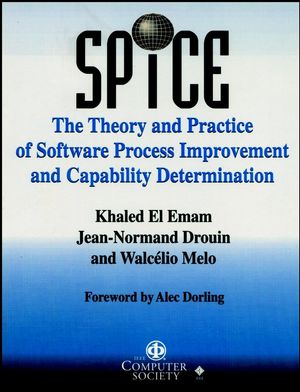SPICE: The Theory and Practice of Software Process Improvement and Capability DeterminationISBN: 978-0-8186-7798-4
Hardcover
496 pages
November 1997, Wiley-IEEE Computer Society Press
 |
||||||
Foreword (Alec Dorling).
Preface.
Acknowledgments.
PART 1.
Chapter 1. Introduction to Software Engineering Standards (Francois Coallier and Motoei Azuma).
Chapter 2. Introduction to SPICE (Jean-Normand Drouin and Harry Barker).
PART 2.
Chapter 3. Introduction to the SPICE Documents and Architecture (Terry P. Rout and Peter G. Simms).
Chapter 4. The Reference Model (Alan W. Graydon, et al.).
chapter 5. Process Assessment Using SPICE: The Assessment Activities (Antonio Coletta).
Chapter 6. Process Assessment Using SPICE: The Rating Framework (Mac Craigmyle).
Chapter 7. The Assessment Model (Carroline Buchman and Helen Thomson).
Chapter 8. Guidelines for Process Improvement (Pascal Jansen and Joc Sanders).
Chapter 9. Guidelines for Determining Supplier Process Capability (John Hamilton).
Chapter 10. Qualification and Training of Assessors (Alan Davies and Alastair Walker).
Chapter 11. A Comparison of ISO 9001 and the SPICE Framework (Victoria A. Hailey).
PART 3.
Chapter 12. Introduction to the SPEICE Trials (Fiona Maclennan, et al.).
Chapter 13. Empirical Evaluation of SPICE (Khaled El Emam and Dennis R. Goldstein).
Chapter 14. Analysis of Assessment Ratings from the Trials (Ian Woodman and Robin Hunter).
Chapter 15. Analysis of Observation and Problem Reports (Peter Marshall, et al.).
Chapter 16. Interrater Agreement in Assessment Ratings (Khaled El Emam and Peter Marshall).
Chapter 17. Using SPICE as a Framework for Software Engineering Education: A Case Study (Val E. Veraart and Sid L. Wright).
Chapter 18. Assessment Using SPICE: A Case Study (Jean-Martin Simon).
Chapter 19. The Future pf the SPICE Trials (Robert Smith).
Appendix A. SEAL of Quality SPICE Assessment Tool.
Appendix B. Strathclyde Process Visualization Tools.
Glossary.
Bibliography.
Index.
Author Biographies.
Preface.
Acknowledgments.
PART 1.
Chapter 1. Introduction to Software Engineering Standards (Francois Coallier and Motoei Azuma).
Chapter 2. Introduction to SPICE (Jean-Normand Drouin and Harry Barker).
PART 2.
Chapter 3. Introduction to the SPICE Documents and Architecture (Terry P. Rout and Peter G. Simms).
Chapter 4. The Reference Model (Alan W. Graydon, et al.).
chapter 5. Process Assessment Using SPICE: The Assessment Activities (Antonio Coletta).
Chapter 6. Process Assessment Using SPICE: The Rating Framework (Mac Craigmyle).
Chapter 7. The Assessment Model (Carroline Buchman and Helen Thomson).
Chapter 8. Guidelines for Process Improvement (Pascal Jansen and Joc Sanders).
Chapter 9. Guidelines for Determining Supplier Process Capability (John Hamilton).
Chapter 10. Qualification and Training of Assessors (Alan Davies and Alastair Walker).
Chapter 11. A Comparison of ISO 9001 and the SPICE Framework (Victoria A. Hailey).
PART 3.
Chapter 12. Introduction to the SPEICE Trials (Fiona Maclennan, et al.).
Chapter 13. Empirical Evaluation of SPICE (Khaled El Emam and Dennis R. Goldstein).
Chapter 14. Analysis of Assessment Ratings from the Trials (Ian Woodman and Robin Hunter).
Chapter 15. Analysis of Observation and Problem Reports (Peter Marshall, et al.).
Chapter 16. Interrater Agreement in Assessment Ratings (Khaled El Emam and Peter Marshall).
Chapter 17. Using SPICE as a Framework for Software Engineering Education: A Case Study (Val E. Veraart and Sid L. Wright).
Chapter 18. Assessment Using SPICE: A Case Study (Jean-Martin Simon).
Chapter 19. The Future pf the SPICE Trials (Robert Smith).
Appendix A. SEAL of Quality SPICE Assessment Tool.
Appendix B. Strathclyde Process Visualization Tools.
Glossary.
Bibliography.
Index.
Author Biographies.



